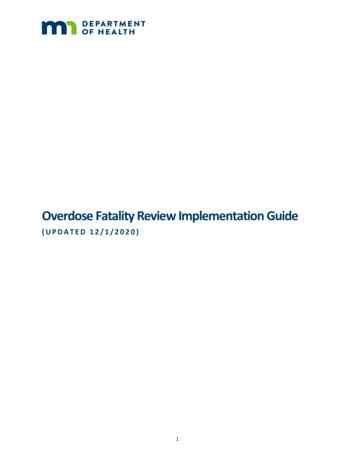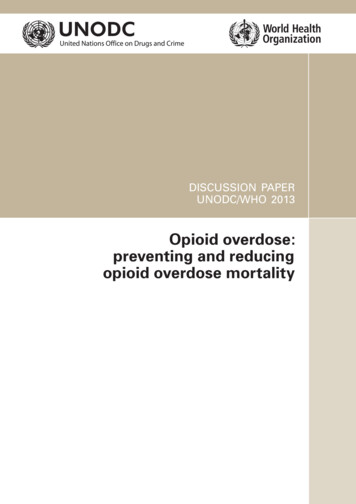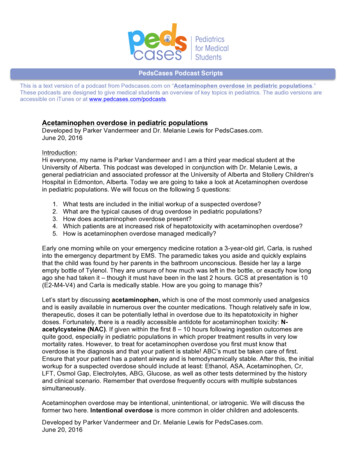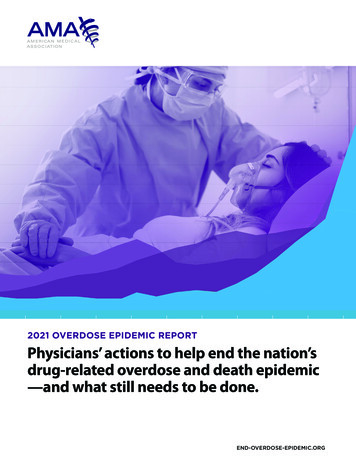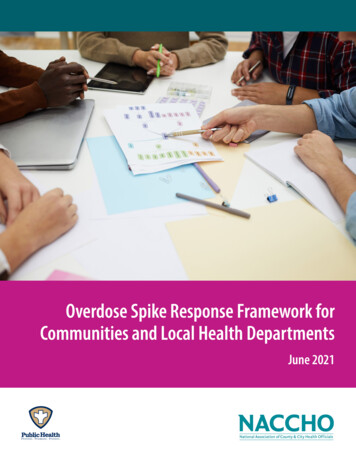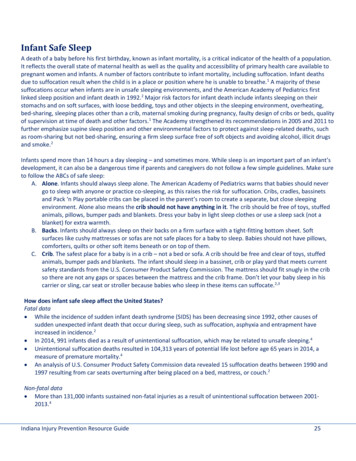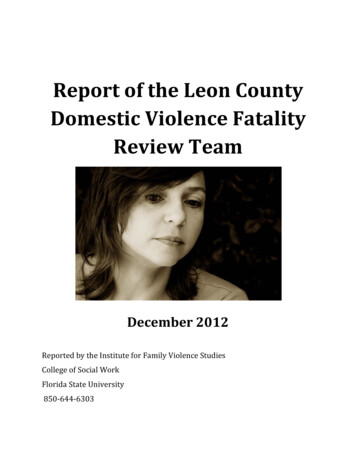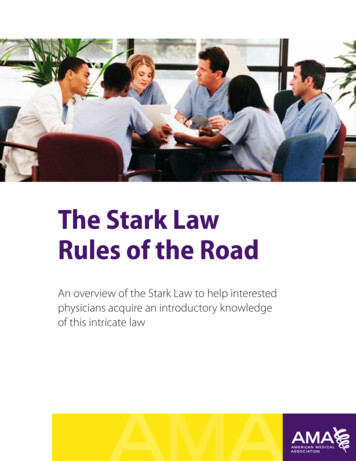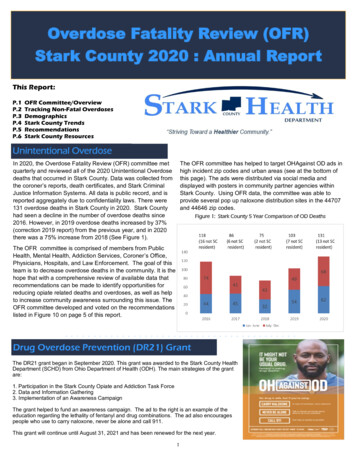
Transcription
Overdose Fatality Review (OFR)Stark County 2020 : Annual ReportThis Report:P.1P.2P.3P.4P.5P.6OFR Committee/OverviewTracking Non-Fatal OverdosesDemographicsStark County TrendsRecommendationsStark County ResourcesUnintentional OverdoseIn 2020, the Overdose Fatality Review (OFR) committee metquarterly and reviewed all of the 2020 Unintentional Overdosedeaths that occurred in Stark County. Data was collected fromthe coroner’s reports, death certificates, and Stark CriminalJustice Information Systems. All data is public record, and isreported aggregately due to confidentiality laws. There were131 overdose deaths in Stark County in 2020. Stark Countyhad seen a decline in the number of overdose deaths since2016. However, in 2019 overdose deaths increased by 37%(correction 2019 report) from the previous year, and in 2020there was a 75% increase from 2018 (See Figure 1).The OFR committee has helped to target OHAgainst OD ads inhigh incident zip codes and urban areas (see at the bottom ofthis page). The ads were distributed via social media anddisplayed with posters in community partner agencies withinStark County. Using OFR data, the committee was able toprovide several pop up naloxone distribution sites in the 44707and 44646 zip codes.Figure 1: Stark County 5 Year Comparison of OD DeathsThe OFR committee is comprised of members from PublicHealth, Mental Health, Addiction Services, Coroner’s Office,Physicians, Hospitals, and Law Enforcement. The goal of thisteam is to decrease overdose deaths in the community. It is thehope that with a comprehensive review of available data thatrecommendations can be made to identify opportunities forreducing opiate related deaths and overdoses, as well as helpto increase community awareness surrounding this issue. TheOFR committee developed and voted on the recommendationslisted in Figure 10 on page 5 of this report.Drug Overdose Prevention (DR21) GrantThe DR21 grant began in September 2020. This grant was awarded to the Stark County HealthDepartment (SCHD) from Ohio Department of Health (ODH). The main strategies of the grantare:1. Participation in the Stark County Opiate and Addiction Task Force2. Data and Information Gathering3. Implementation of an Awareness CampaignThe grant helped to fund an awareness campaign. The ad to the right is an example of theeducation regarding the lethality of fentanyl and drug combinations. The ad also encouragespeople who use to carry naloxone, never be alone and call 911.This grant will continue until August 31, 2021 and has been renewed for the next year.1
Tracking Non– Fatal Opioid OverdosesTracking non fatal opioid overdoses has continued to be afocus of the OFR team. The data above in Figure 2 wascollected from the following sources: Stark County CoronersOffice, EMS Incident Reporting System, and Ohio’s EpiCenter.This data provides a comparison of overdose deaths, EMSadministration of naloxone, and emergency department visits.Figure 2 : Stark County Fatal vs, Non-Fatal Overdoseswas used with fewer visits to the emergency department, Figure2. It is important to note that in the middle of 2019 theepicenter classifier which filters the ED visits at the state levelchanged to more specifically reflect OD visits in Ohio EDsettings. SCHD monitors EpiCenter ED visits on a weeklybasis and these reports can be found using the link /nursingservices/overdose-prevention.When looking at data from quarter 1 in 2019, more naloxoneOD Deaths by Zip CodeFigure 3 : Case Residence by Zip CodeFigure 3 shows thehighest incident zipcodes for the 2020decedents by wherethe person lived.The darker shadesrepresent higherincidents while lighter shades representlower incident zipcodes.2
Stark County DemographicsOf the overdose deaths thatoccurred in Stark County, themajority continue to be non Hispanicwhite males. The age group withthe highest rate in previous yearshas been 25-34. However, in 2019,this age group shifted to be 35-44,with 25-34 being close behind. Thiscontinues to be the case for 2020.There continues to be an increasein the 65 and over age group whencompared to previous years.Figure 4: Stark County Death Rate by Age GroupAnother area discussed and trackedis race data. Figure 5, shows thepercentage of total deaths by race,as well as the rate of death by raceper 100,000 population. AlthoughFigure 5: Race Rate per 100,000the highest percentage of deaths fall and Percentagesinto the white category when lookingat rate per 100,000 population, theblack rates are significantly higherand have doubled since 2018.Multiracial decedents make up 1%of the deaths and there was onedecedent who was Hispanic.Figure 6: Gender Rate per 100,000and PercentagesThe majority of OD deaths havebeen male however, in recent yearswe have seen an increase in femaledeaths. The female death rate in2019 was 20.4 as compared to2020 the rate increased to 25.5.Strategic Plan Update—Stark County Mental Health & Addiction Recovery(STARKMHAR)The strategic plan was updated by the strategic planning leadership committee and presented at the Opiate and Addiction TaskForce meeting (OATF). The leadership restructured work groups by merging old groups and adding a new group, theinnovation work group. The following is the overall goal of each work group:Community Partnerships- The goals of the Community Partnerships workgroup are to promote task force membership, engage a morediverse group of community partners in Task Force activities, and increase community awareness of available resources.Data- The Data group works to increase access to data, identifies gaps or areas for improvement, and mobilizes services based on identifiedneeds.Education & Advocacy- The Education & Advocacy workgroup deals with educational resources and training related to opioids, addiction,and related topics, assessing what is available in our community and looking for gaps that can be filled. The ultimate goal is to reduce stigmaaround addiction, establish standards for quality treatment,and advocate for the diverse needs of those affected byFigure 7: StarkMHAR Strategic Plan Work Group Structureaddiction.Innovation- The Innovation workgroup is concerned withharm reduction efforts including naloxone distribution andsyringe exchange programs. Project DAWN sites andagencies with these programs are encourages toparticipate and share best practices and innovationstrategies.3
Identified TrendsFigure 8: Raw number/Percent of Decedents Positive for Opiates Drug CombinationsDrug CombinationRaw number/PercentageOpiate/Stimulant (Cocaine, Methamphetamine, Amphetamine)62/47%Opiate/Sedative (Benzodiazepam, Anticonvulsant, Gabapentin, Anti histamine,60/46%Phenobarbital, Lyrica, Alcohol)Opiate/Marijuana25/19%Figure 8, shows positive toxicology results for drug combinations of Stark County Overdose decedents. An opiate couldrepresent prescription or illicit drugs. Drug combinations continue to be a high risk factor for overdose. Additionally,from 2012 all the way to 2018 the percentage of heroin/fentanyl present in the toxicology screens has steadily increasedwith a slight decrease in 2018 and 2019. However, the percentage of those decedents with Heroin/Fentanyl present hasincreased from 64% in 2019 to 76% in 2020. 18% of the 131 decedents in 2020 were non-opiate related overdosedeaths, with one of those being an insulin overdose. In 2019, 25% of the 103 decedents were non-opiate relatedoverdose deaths.Figure 9: Illicit Drugs and re 9, above illustrates the percentage of illicit substances and alcohol present in the 2020 unintentional overdosedecedents. Marijuana has decreased steadily over the past several years. Methamphetamine and alcohol has steadilyincreased over several years while cocaine continues to decrease in the percentage of decedents testing positive.Heroin use continues to decrease while fentanyl/fentanyl analogs continue to increase in toxicology results (see Figure 8description above).4
RecommendationsFigure 10: OFR Recommendations The OFR committee encourages and supports the innovated distribution of naloxone through law enforcement, Project DAWNsites, jails, emergency departments, leave behind programs treatment centers, pop-up sites, syringe exchange program andmail in order.2.The OFR committee recommends the use of screening tools in both medical/dental provider’s offices and emergencydepartment’s to screen for individuals who are at risk of or currently suffering from substance use disorders.3.The OFR committee recommends implementation of a comprehensive referral system in the emergency department’s whichincludes (peer support/harm reduction services).4.The OFR committee recommends Medication Assisted Treatment (MAT) availability through emergency department settingswithin Stark County and continue MAT through jail settings.5.The OFR committee supports the development/implementation of real time data tracking software systems focused onoverdose information such as High Intensity Drug Trafficking (HIDTA) OD map and local dashboards.6.The OFR committee encourages more access to treatment efforts and awareness programs related to addiction resources,educational materials and harm reduction services such as expansion of innovated treatment programs.7.The OFR committee recommends community based programs to address the racial and gender disparities among overdosevictims.8.The OFR committee recommends that local health departments, StarkMHAR, local government leadership, local lawenforcement, EMS, Hospitals, the Coroners office, EMA and treatment centers participate in reporting increase overdoseactivity and actively participate in assigned roles when the Community Response Plan is initiated.9.The OFR committee supports the efforts and initiatives of the Opiate and Addiction Task Force hosted by StarkMHAR.Figure 10 above outlines the recommendations developed by the OFR committee. The recommendations were developed utilizing a variety of surveys, OFR data/trends identified from coroners reports, and the Centers for Disease Controland Prevention evidence-based strategies for preventing opioid overdose.Comprehensive Sustainable System—Criminal Justice SettingDeveloping a Comprehensive Sustainable System (CSS) within a criminal justice setting builds upon previous programming at the Stark County Jail. Efforts were made to link these systems and create a continuum of prevention, harm reduction and treatment access. Several components of the CSS were already in place, and gaps were identified as peersupport referrals and naloxone distribution. Sustainability was considered in the strategy of training probation officers todistribute Narcan to participants. The second year of the grant, from September 2021 to August 2022, will focus on newcomponents of the CSS, see Figure 11.Figure 11. Infographic of Comprehensive Sustainable System Components5
Stark County ResourcesOpiate Hotline: 330-454-HELP (4357)Community information, education, support and connection to services anytime.Project SWAP (Needle Exchange Program)Canton City Health Department- 330-489-3322TreatmentColeman Behavioral Health – Crisis Hotline- 330-452-6000CommQuest Services– 330- 455-0374Canton Detox and Recovery Unit - 330- 830-3393Brightview Canton Addiction Treatment Center - 1-833-510-HELPAVO Behavioral Health and Recovery - 330-331-7506Project DAWN SitesAlliance City Health Department– 537 E. Market St. 330-821-7373 ext. 13Coleman Behavioral Health/Crisis Center– 242113th St. NW Canton 330-452-6000CommQuest Services– 1341 Market Ave. N. Canton 330-453-8252Stark County Health Department— 7235 Whipple Ave. NW North Canton 330-451-1678Helpful WebsitesStark County Mental Health & Addiction Recovery (StarkMHAR): https://starkmhar.org/Stark County Health ursing-services/overdose-preventionTake Charge Ohio: takechargeohio.orgThis work is funded either in whole or in part by a grant awarded by the Ohio Department of Health, Office of Health Improvement andWellness Violence and Injury Prevention Section and as a sub-award of a grant issued by the Centers for Disease Control and Preventionunder the Overdose Data to Action grant, grant award number grant 1 NU17CE924989-01-00, and CFDA number 93.136References:1. Death Statistics were from the Stark County Coroners Office, data was pulled fromthe Ohio Department of Heath’s EpiCenter database Gender and Population data(death rates) was taken from the 2018 U.S. Census Bureau American Community Survey data;5year estimate2. Ohio Department of Public Safety, Division of Emergency Medical Services, EMSIncident Reporting System3. Ohio Automated Prescription Reporting System (OARRS) Ohio Board of Pharmacy6
P.4 Stark County Trends P.5 Recommendations P.6 Stark County Resources In 2020, the Overdose Fatality Review (OFR) committee met quarterly and reviewed all of the 2020 Unintentional Overdose deaths that occurred in Stark County. Data was collected from the coroner's reports, death certificates, and Stark Criminal Justice Information Systems.

